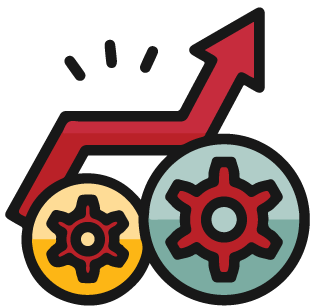In today’s Osmosis from Elsevier blog, we’re exploring the intricate relationship between economic stability and health outcomes in the United States, where economic factors profoundly influence healthcare access and quality for both the healthcare system and individual patients. In past articles, we’ve explored several of the social determinants of health, including access to healthcare, neighborhoods and built environments, and education access and quality. Now, let’s examine economic stability.

Impact of Economic Stability on Health
Meet John, a 27-year-old recent graduate whose journey after completing his education has been marred by many challenges. Despite his academic achievements, long-term unemployment has plunged John into severe financial stress, triggering feelings of inadequacy and eventually leading to a diagnosis of anxiety and depression. His situation is compounded by the harsh realities of healthcare coverage. He’s unable to afford COBRA (an expensive, temporary type of employer-sponsored insurance coverage offered after losing a job) and ineligible for Medicaid; John finds himself caught in a gap made worse by the age limit set by the Affordable Care Act (ACA), which restricts applying parental insurance coverage to children up to 26 years old. Despite the ACA’s intention to provide an accessible medical marketplace, navigating these systems is difficult for individuals with mental health challenges like John, who’s having a hard time completing basic daily tasks, leaving him struggling to complete the steps necessary to secure essential healthcare services.
Access to healthcare in the US is closely tied to economic and political stability. Approximately one in ten Americans live in poverty, facing daily challenges in affording necessities like healthy food, healthcare, and stable housing. Economic stability directly impacts employment opportunities and income levels, improving the ability to access healthcare and maintain a decent quality of life.

Nutrition and food insecurity further underscore the complex give and take between economic circumstances and health outcomes. Consider the challenges for Tricia, a single mother of two, grappling with the financial strain of providing nutritious meals on a limited income. Constrained by financial resources, she often resorts to purchasing inexpensive, processed foods that are calorie-dense but nutrient-poor. This dietary compromise not only affects her health but also poses long-term risks for her children, contributing to higher rates of obesity and diabetes among lower-income families.

How Disparities in Economic Stability Affect Health Outcomes
Disparities in economic stability contribute significantly to health inequities, evident across various socioeconomic groups.
Meet Oscar, a middle-aged man struggling with chronic health conditions made worse due to financial constraints. Unable to afford out-of-pocket medical costs and lacking health insurance coverage, Oscar faces the grim reality of neglecting his health due to the inability to pay for services. Similarly, individuals like Oscar confront the stark choice between meeting basic needs like food and shelter or accessing necessary medical treatments, highlighting how socioeconomic status contributes to our health.
These disparities are compounded by racial and ethnic differences, with Black, Indigenous, and People of Color (BIPOC) communities disproportionately affected by systemic barriers, which are the policies, procedures, or practices that prevent individuals from fully participating in a system due to unfair, discriminatory practices, such as having lower incomes, lower quality or less education, higher unemployment rates, and reduced access to quality healthcare. These structural inequities translate into worse health outcomes, shorter life expectancies, and limited opportunities for preventative care among marginalized populations.

In rural America, geographic disparities amplify the challenges related to economic stability and healthcare access. Emily, a young, expectant mother in a small rural town, faces daunting obstacles in accessing essential medical services located miles away from her home. Limited job prospects and low wages in her community further increase her struggles, making healthcare unaffordable even when it’s available. In contrast to urban residents who often have better access to healthcare facilities and higher-paying jobs, Emily experiences increased economic and health disparities simply due to where she lives.
To address the health disparities Emily faces due to economic instability, she needs her local representatives to implement targeted policies and interventions that bridge these regional gaps. Currently, grassroots programs like Habitat for Humanity, Homes for Hero, and Housing Plus can be instrumental in offering a helping hand to people like Emily. There are also city, state, and federal programs that providers should keep as a reference for patients. These programs provide essential support, from affordable housing to financial stability, helping them secure a healthier future.
As a healthcare provider, make a habit of reviewing and addressing your patient’s living situations during history taking and implementing address change or status protocols, as needed. In addition, work to create and maintain patient-provider relationships through trust, security, and listening with an open, nonjudgmental ear. A compassionate approach to care is critical to recognizing and addressing the broader issues affecting patients’ health.

Policies and Interventions Addressing Economic Stability
Social safety net programs such as Medicaid are pivotal in supporting people grappling with financial hardships. Other programs, such as unemployment benefits, food assistance initiatives, and affordable housing programs offer relief for those who are struggling.
Consider Maria and Carlos, a hardworking couple juggling multiple jobs to make ends meet for their family. Despite their dedication to their work, they face persistent financial instability, housing insecurity, and limited access to healthcare services. Carlos has headaches, along with a hypertensive spike, because of the strain of balancing work and family responsibilities. Due to lack of insurance, Carlos is at higher risk of Kidney Failure, Stroke, or Heart Failure, which may all lead to his death, but not before he makes multiple visits to the Emergency Department (while accumulating large amounts of medical debt). To help get Carlos the care he needs, his health providers helped him get on Medicare and Medicaid and referred the couple to an affordable housing program.
Maria and Carlos’ situation underscores the need to educate patients on their rights and privileges regarding their healthcare and the necessity of federal and state policy changes that ensure fair wages and expand access to affordable housing and healthcare.

Strategies for Improving Economic Stability and Health
Affordable housing initiatives offered a necessary lifeline for Maria and Carlos. Their neighbor, Tara, struggles with chronic asthma aggravated by mold infestation in her apartment. She has limited options because she is underpaid and has no insurance, even though she works 40 hours per week. Exploring programs like Section 8 vouchers or local housing assistance could improve her living conditions. At the same time, healthcare subsidies or Medicaid expansion benefits could provide her with essential medical care.
The challenge is that the availability and effectiveness of these programs hinge on city, state, and federal funding allocations, emphasizing the critical role of advocacy and policy reform in shaping healthcare equity. Individually, we can enact change through our right to vote by electing representatives who support equality and equity. By advocating for equitable healthcare policies and investing in community-based health initiatives, stakeholders (otherwise known as you and me) can collaborate to lessen the impact of social determinants such as income inequality and systemic barriers on health outcomes.

David, a senior from a rural community, grapples with the limited transportation options that prevent him from making essential medical visits and trips to the grocery store to get healthy food. These barriers hinder his access to vital services and limit his social connections, worsening health disparities rooted in mobility challenges. Despite local efforts to bridge these transportation gaps with programs like a volunteer-staffed van service, David continues to face significant obstacles to maintaining his health. Community-driven initiatives like enhanced transportation options and strengthened social network opportunities offer promising avenues to improve David’s well-being, highlighting the transformative impact of addressing social determinants of health.
Advocacy, policy reform, and community-based programs are instrumental in shaping healthcare access, addressing inequities in the social determinants of health, and influencing patient outcomes across diverse populations. In David’s community, the creation of a phone tree for carpooling, along with neighbors rallying for food delivery services such as (Doordash, UberEATS, and Instacart), has helped him have more accessible options, along with providing employment for younger members of his community. As a provider, being informed about programs such as WIC, SNAP (aka food stamps), and Meals On Wheels can help close the gap in health disparities.
By championing expanded healthcare coverage, affordable medication, and community-based health initiatives, clinicians and advocates can strive to address and lessen the pervasive effects of income inequality and systemic barriers to health equity.
Conclusion
Imagine a bustling town where economic stability isn’t just a buzzword but woven into the fabric of everyday life. Here, decisions made at City Hall help families afford fresh vegetables or access affordable housing. Economic and political stability directly influence health outcomes by shaping everything from employment opportunities to healthcare accessibility.
Due to the complexities of the American healthcare system, US-based clinicians need to understand the social determinants of health. Economic stability significantly impacts healthcare access, quality, and patient outcomes, so understanding its impact on policies that define the availability and standard of care is vital. The stories of John, Oscar, Emily, Carlos, Maria, and Tara help us understand how economic disparities perpetuate health inequities across socioeconomic, racial, and geographic lines.
Take the time to team up with your patients and neighbors to champion fair healthcare policies and pour resources into programs that tackle the root causes of health disparities. Together, we can break down barriers and boost health outcomes for everyone. It’s a collaborative adventure in healthcare, where equity is the name of the game, and everyone gets to win.

 Podcast
Podcast




 Features
Features






